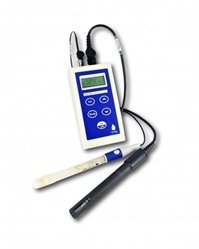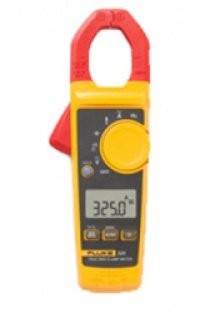How To Calibrate The TPS Aqua-CPA Conductivity-TDS-Temp-pH Water Tester

For consistent and accurate measurements when using your Aqua-CPA, it is essential to perform frequent pH and conductivity calibrations. This how-to guide explains the correct calibration method for the Aqua-CPA and provides helpful tips along the way.
Figure 1 Watch an Instrument Choice scientist demonstrate how to calibrate the TPS Aqua-CPA Conductivity-TDS-Temp-pH Water Tester here.
Materials
- The Aqua-CPA Conductivity-TDS-Temp-pH Water Tester
- pH Sensor (Included)
- Cond-TDS-Salinity-pH-Temperature Sensor (Included)
- 00 Buffer
- 01 Buffer
- 1413uS/cm Conductivity Standard
- Distilled Water
pH Calibration
|
pH Calibration Note 1: A “ ∗ ” in place of the decimal point indicates that the pH readout is not calibrated or a past calibration has failed. The “ ∗ ” will be removed once a full two-point pH calibration is successfully performed. pH Calibration Note 2: To perform calibration with automatic temperature compensation, you must use both the pH AND conductivity probe. |
pH Automatic Buffer Selection
The Aqua-CPA Conductivity-TDS-Temp-pH Water Tester is factory set to recognise pH4.01, pH6.86 and pH9.18 buffers automatically. If you prefer to use pH7.00 instead of pH6.86 and pH10.01 instead of pH9.18, you can adjust which buffers are automatically recognised. To do this:
- Switch the meter off
- Press and hold the CAL key, then press the ON/OFF button to switch on the meter
- Release the CAL key when the message “Buffer 1 Select” displays
- Use the up and down keys to switch between automatic buffer recognition of pH7.00 or pH6.86; then
- When your required buffer is on the LCD, press MODE to confirm.
- On the next screen, use the up and down keys to switch between automatic buffer recognition of 4.01 and 9.18 or 4.01 and 10.0.
- When your selection is on the screen, press MODE to confirm, the buffer recognition setting will be saved.
Two-Point pH Calibration
- Press the MODE key to navigate to a display mode showing pH readout.
- Rinse the pH and conductivity sensors in distilled water.
- Immerse the pH and conductivity sensors into a small sample of pH7.00 buffer, ensuring that the bulb and reference junction are both covered.
- Wait for the reading to stabilise.
- When the reading is stable, press the CAL key to calibrate. NOTE: If you are in a combination display, you will be prompted to select the parameter for calibration - otherwise, press no keys.
- When calibration is successful, “Cal 1P OK” and the asymmetry value will appear on the LCD. The first point of calibration is complete.
- Rinse the pH and conductivity sensors in distilled water.
- Place the sensors into the next buffer solution of pH 4.01 and wait for the reading to stabilise
- When the reading has stabilised, press the CAL key to calibrate.
- If the second point of calibration has been successful, the Aqua-CPA will display “2 point 4.01 CAL OK” for a moment and then display the asymmetry and slope values.
- The Aqua-CPA will automatically return to measurement mode. Two-point pH calibration is complete!
Conductivity Calibration
|
Conductivity Calibration Note 1: A “∗” in place of the decimal point indicates that the Conductivity or TDS or Salinity readout is not calibrated, or a past calibration has failed. The “ ∗ ” will be removed once a conductivity calibration is performed successfully with an acceptable conductivity standard. Conductivity Calibration Note 2: Allowable Conductivity standards for the Aqua-CPA are; 150µS/cm, 1413µS/cm, 2.76mS/cm, 12.88mS/cm, and 58.0mS/cm Conductivity Calibration Note 3: The TDS and salinity values are derived from the conductivity reading and do not require a separate calibration. |
Conductivity Zero Calibration
Zero calibration should be performed at least monthly. In low conductivity applications, a zero calibration should be performed more frequently to ensure accuracy, e.g. weekly.
- Press to MODE button to find a display screen with either conductivity, TDS or salinity value readout.
- Rinse the conductivity sensor in distilled water. Then shake off as much water as possible and blot the outside of the sensor dry. Do not blot the sensor wires.
- Leave the sensor to air dry.
- When the sensor is dry and the reading on the meter has stabilised at or near zero, press CAL. The Aqua-CPA will display the zero value of the sensor. Zero calibration is complete.
Conductivity Standard Calibration
A standard calibration should be performed at least weekly.
- Rinse the conductivity sensor in distilled water. Shake off as much water as possible. Blot the outside of the sensor dry. Do not blot the sensor wires.
- Immerse the probe into the standard solution. Ensure the vent hole on the conductivity probe is immersed in the standard solution.
- Wait for the reading to stabilise.
- When stable press the CAL key to calibrate, the Aqua-CPA will confirm the automatically recognised standard and then display the calculated k-factor of the sensor before returning to measurement mode.
- Rinse the probe in distilled water. Conductivity calibration is complete.
Conclusion
pH and conductivity meters require regular calibration to ensure accurate measurements. pH and conductivity calibration could not be more straightforward on the Aqua-CPA and will take only a matter of minutes.
Time-consuming calibration procedures are a thing of the past!
For more information on the TPS Aqua-CPA Conductivity-TDS-Temp-pH Water Tester, see the links below or contact us!
Additional links
- The AQUA-CPA Conductivity-TDS-Temp-pH Water Tester is available with the following sensor cable lengths:
- The AQUA-CPA Conductivity-TDS-Temp-pH Water Tester comes with the required pH and conductivity solutions for calibration. Replacement buffer solutions are available here.
- Browse the full range of intelligent and Australian-made water quality testers by TPS here.
- Watch “How To Setup The TPS Aqua-CPA Conductivity-TDS-Temp-pH Water Tester” again
- Want to see what comes in the box? Watch a scientist “ "Unboxing the TPS Aqua-CPA Conductivity-TDS-Temp-pH Water Tester."

Also interesting
Digital clamp meters are popular tools used by electricians and electrical contractors to obtain measurements from:
- industrial controls and equipment
- electrical systems; and
- commercial HVAC systems.
This article further defines what digital clamp meters are, lists their benefits, then highlights some typical product examples, including notable features and applications.

The Davis Vantage Vue is one of the world's most popular weather stations. Boasting an impressive range of features, the Vantage Vue is of excellent quality, value-for-money, and suited to both home and professional applications.
To take the burden out of finding the ideal setup for your application, our scientists have assembled a complete guide to the Vantage Vue Kits available at Instrument Choice detailing the kit inclusions and how you can access your weather data.

